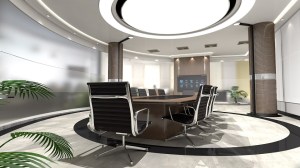What Do Top Executives Look For in an Office?
Emily Kream, director of construction with Irvine Co., discussed the current trends in C-suite workspace design and what makes the Chicago office market stand out.
By Roxana Baiceanu
Corporate culture is undergoing a few changes—from integrating technology and creating energy-efficient offices to narrowing down the gap between C-level executives and the rest of the employees. This dynamic requires a series of innovations, especially when it comes to office design trends.
“Thoughtful design and technology integration is essential to bolstering efficiency in the workplace. Office spaces have grown more diverse to support where and how people work. Providing the right technology at different touch down spaces has the ability to make or break the overall effectiveness of the office layout,” said Emily Kream, director of construction with Irvine Co., with whom Commercial Property Executive discussed the current office preferences of C-suite industry professionals.
Kream highlighted the fact that top executives still see the traditional corner office as necessary for private talks but are increasingly open toward shared spaces, which are seen as more egalitarian. Additionally, open spaces offer the possibility to interact with the rest of the employees.
From your experience so far, what are the top three amenities C-level executives look for when it comes to their office?
Kream: In Chicago, the C-suite is looking for amenities that focus on and enhance the prestige of wherever they plan to lease space. Some of these include beautiful, expansive views from the space, a well-appointed gym or fitness option, a full service dining area with different food choices and a conference center that is equipped with the right technology. C-level executives expect custom experiences that are intentionally designed for their needs.
Of course, these needs vary depending on the industry each executive comes from. A larger corporation with more leased space will likely have different needs and wants than a smaller company taking less space.
Has the corner office been completely removed from the new office design? If not, will it ever be?
Kream: The corner office has definitely not gone away but we are seeing, gradually over time, more and more groups shy away from it. We’re seeing a more egalitarian approach to the way office spaces are configured and it is certainly the way of the future.
However, the perimeter office concept is still prominent with companies in the financial and law sectors. The nature of those businesses tends to require a bit more “closed-door” work. Overall though, from a design trend perspective, we’re seeing companies push for reductions in the amount of actual offices they are providing.

Source: Festoon House
What alternatives to the traditional office are popular among top executives?
Kream: C-level executives don’t necessarily prefer one type or layout of office space to the traditional office. The most important element for them is that the space is thoughtfully designed to address privacy concerns and encourage collaboration, regardless of the layout.
Executives need to know that there is a designated place for employees to go, either to communal areas, meeting rooms or enclosed, private conference rooms, to have productive and private conversations. To make these areas effective, well-planned layouts are essential.
Is the general trend that of shrinking or making C-level offices larger?
Kream: I would have to say that the general trend is that of shrinking C-level offices. Companies are constantly working to make things more efficient and as dense as possible.
What other factors are starting to play a decisive role in today’s office design?
Kream: In general, the younger workforce is putting more emphasis on access to outdoor space and amenities that improve quality of life and productivity in the workplace. Some of these might include customized workspaces to fit the needs of different departments, greener workplace environments and more active workplace environments. With regard to actual workspace design, there is a more egalitarian design direction being demanded.
It’s important for companies and the C-suite to note, from a recruitment and retention standpoint, that adding statement amenities that reflect a company’s core values, like a mother’s room, deliver the greatest return on investment.
Is Chicago following the latest trends in office design or is it a more traditional market?
Kream: Chicago is a little more traditional but that does not necessarily correlate with falling behind on trends. Office customers and companies in Chicago are quite sophisticated and have a high level of expectation for the spaces they are in. Not to mention, there is a steady new development pipeline here, which has lent itself to a constant need to remain relevant and cutting edge to compete with the latest new developments. From a trends perspective, I’d say that Chicago is very competitive when it comes to overall innovation in office design.
Image courtesy of Irvine Co.









You must be logged in to post a comment.